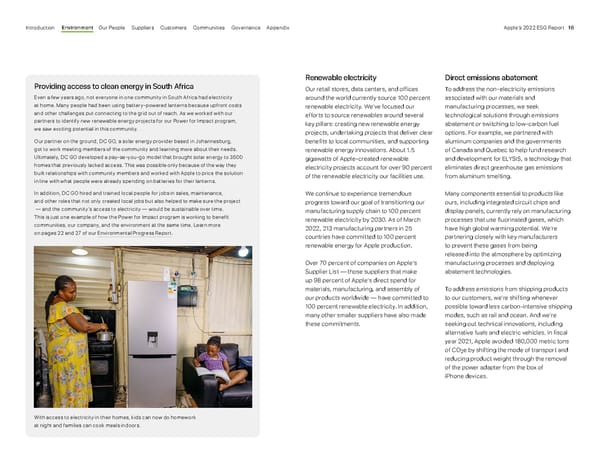Renewable electricity Our retail stores, data centers, and offices around the world currently source 100 percent renewable electricity. We’ve focused our efforts to source renewables around several key pillars: creating new renewable energy projects, undertaking projects that deliver clear benefits to local communities, and supporting renewable energy innovations. About 1.5 gigawatts of Apple-created renewable electricity projects account for over 90 percent of the renewable electricity our facilities use. We continue to experience tremendous progress toward our goal of transitioning our manufacturing supply chain to 100 percent renewable electricity by 2030. As of March 2022, 213 manufacturing partners in 25 countries have committed to 100 percent renewable energy for Apple production. Over 70 percent of companies on Apple’s Supplier List — those suppliers that make up 98 percent of Apple’s direct spend for materials, manufacturing, and assembly of our products worldwide — have committed to 100 percent renewable electricity. In addition, many other smaller suppliers have also made these commitments. Direct emissions abatement To address the non-electricity emissions associated with our materials and manufacturing processes, we seek technological solutions through emissions abatement or switching to low-carbon fuel options. For example, we partnered with aluminum companies and the governments of Canada and Quebec to help fund research and development for ELYSIS, a technology that eliminates direct greenhouse gas emissions from aluminum smelting. Many components essential to products like ours, including integrated circuit chips and display panels, currently rely on manufacturing processes that use fluorinated gases, which have high global warming potential. We’re partnering closely with key manufacturers to prevent these gases from being released into the atmosphere by optimizing manufacturing processes and deploying abatement technologies. To address emissions from shipping products to our customers, we’re shifting whenever possible toward less carbon-intensive shipping modes, such as rail and ocean. And we’re seeking out technical innovations, including alternative fuels and electric vehicles. In fiscal year 2021, Apple avoided 180,000 metric tons of CO 2 e by shifting the mode of transport and reducing product weight through the removal of the power adapter from the box of iPhone devices. Providing access to clean energy in South Africa Even a few years ago, not everyone in one community in South Africa had electricity at home. Many people had been using battery-powered lanterns because upfront costs and other challenges put connecting to the grid out of reach. As we worked with our partners to identify new renewable energy projects for our Power for Impact program, we saw exciting potential in this community. Our partner on the ground, DC GO, a solar energy provider based in Johannesburg, got to work meeting members of the community and learning more about their needs. Ultimately, DC GO developed a pay-as-you-go model that brought solar energy to 3500 homes that previously lacked access. This was possible only because of the way they built relationships with community members and worked with Apple to price the solution in line with what people were already spending on batteries for their lanterns. In addition, DC GO hired and trained local people for jobs in sales, maintenance, and other roles that not only created local jobs but also helped to make sure the project — and the community’s access to electricity — would be sustainable over time. This is just one example of how the Power for Impact program is working to benefit communities, our company, and the environment at the same time. Learn more on pages 22 and 27 of our Environmental Progress Report . With access to electricity in their homes, kids can now do homework at night and families can cook meals indoors. Appendix Governance Communities Suppliers Customers Our People Environment Introduction Apple’s 2022 ESG Report 16
 ESG Report | Apple Page 15 Page 17
ESG Report | Apple Page 15 Page 17